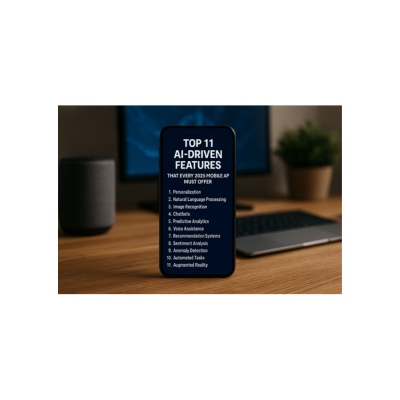The landscape of mobile applications is undergoing a profound transformation, driven by the relentless advancement of Artificial Intelligence (AI). What was once considered futuristic is rapidly becoming a standard expectation for users in 2025. Apps are no longer just tools; they are intelligent companions that anticipate needs, streamline tasks, and deliver hyper-personalized experiences. For any business involved in Mobile App Development, integrating sophisticated AI features is no longer an option but a critical strategy for market relevance and user engagement.
A forward-thinking Mobile App Development Agency recognizes that AI is the bedrock of future-proof mobile solutions. They understand that AI empowers apps to learn from data, adapt to user behavior, and provide dynamic, context-aware interactions that foster deep user loyalty. The competitive edge in the mobile ecosystem will increasingly belong to those who seamlessly weave AI into the very fabric of their applications.
Here are 11 indispensable AI-driven features that every 2025 mobile app must offer:
1. Hyper-Personalization and Predictive Analytics
The era of one-size-fits-all experiences is definitively over. In 2025, mobile apps must exhibit a profound understanding of each individual user. AI-powered hyper-personalization leverages predictive analytics to tailor content, recommendations, and services with unprecedented precision.
How it works: AI models continuously analyze user data – including in-app actions, purchase history, Browse patterns, device usage, and even biometric inputs – to construct dynamic, evolving user profiles. Based on these profiles, the app proactively recommends products, content, or features highly relevant to the user’s current needs or future interests, moving beyond simple demographics to anticipate desires.
2. Advanced Conversational AI (Chatbots & Voice Assistants)
Conversational interfaces have matured far beyond rudimentary chatbots. By 2025, AI chatbots and voice assistants within mobile apps will be expected to handle complex, multi-turn conversations with a high degree of naturalness and empathy.
How it works: Leveraging Natural Language Understanding (NLU) and Natural Language Generation (NLG), these AI interfaces can genuinely comprehend context, intent, and even sentiment in natural human language, generating human-like responses. They retain conversational memory across sessions, offering proactive assistance based on in-app behavior, and enabling users to complete intricate tasks purely through conversational dialogue, from customer support to complex transactions.
3. Intelligent Image & Video Recognition (Computer Vision)
Harnessing the power of computer vision and deep learning, mobile apps in 2025 will unlock groundbreaking visual AI capabilities, enabling apps to understand and interact with the visual world around the user in real time.
How it works: Users can point their camera at an object, and the app can identify it, provide information, or suggest related products/services. AI enhances Augmented Reality (AR) experiences with more accurate object tracking and spatial mapping. It automatically tags, categorizes, and organizes user-generated visual content, and enables real-time image/video analysis for advanced features like facial recognition for security, or intelligent photo editing.
4. Proactive Anomaly Detection & Enhanced Security
With the ever-increasing sophistication of cyber threats, AI is becoming an indispensable guardian of mobile app security. In 2025, AI will move beyond reactive measures to proactively identify and neutralize risks, safeguarding user data and app integrity.
How it works: AI continuously analyzes unique user interaction patterns (behavioral biometrics) to detect deviations that might signal unauthorized access. For financial apps, AI monitors transaction patterns to flag suspicious activities in real-time, preventing fraud. AI algorithms also analyze network traffic and app logs to identify unusual patterns indicative of malware, phishing attempts, or unauthorized data access, providing adaptive authentication based on context.
5. AI-Powered Content Creation & Curation
The emergence of generative AI is empowering mobile apps to not only personalize and curate content but also to actively create it, fundamentally changing how users consume and express information.
How it works: AI can automatically summarize long articles or documents, saving users time. It goes beyond simple categorization to curate personalized news feeds that are highly relevant and offer diverse perspectives. Users can leverage AI to generate short texts (e.g., social media captions, email drafts) or even unique images and illustrations based on simple text inputs, transforming passive consumption into active creation.
6. Adaptive UI/UX and User Behavior Prediction
The app’s interface itself will become intelligent, dynamically adjusting to user needs, habits, and even emotional states, making the interaction profoundly more intuitive and responsive.
How it works: AI learns which features a user accesses most frequently at certain times or in specific contexts, proactively highlighting or surfacing those elements for efficiency. The app’s layout might subtly shift or re-prioritize information based on an individual’s typical usage patterns. AI can predict the user’s likely next action, making the app feel incredibly prescient and reducing friction in navigation.
7. Emotional AI and Sentiment Analysis
A deeper level of user understanding is emerging with Emotional AI, enabling apps to perceive and respond to user emotions. This allows for a more empathetic and tailored interaction.
How it works: Through analyzing text input, voice tone, facial expressions (with consent), or even biometric data (like heart rate), AI can infer a user’s emotional state (e.g., frustration, joy, confusion). The app can then adapt its responses, offer specific help, or adjust its UI to de-escalate negative emotions or enhance positive ones, leading to a truly personalized and supportive user experience.
8. Enhanced Contextual Awareness & Proactive Recommendations
Beyond mere location, advanced contextual AI enables apps to understand the full user environment – including time of day, activity, ambient conditions, and even calendar events – to provide truly proactive and highly relevant recommendations.
How it works: An app can use AI to understand that a user is commuting, at home, in a meeting, or exercising. Based on this rich context, it can proactively suggest relevant actions, content, or services (e.g., “You’re near your favorite coffee shop, would you like to order your usual?”, “It’s almost time for your workout, here’s a recommended playlist,” or “Based on your meeting schedule, here’s a relevant industry news digest.”).
9. AI-Driven Accessibility and Inclusivity
AI is a powerful enabler for making mobile apps truly accessible to everyone, irrespective of their abilities. In 2025, apps will proactively adapt to diverse user needs, promoting inclusivity.
How it works: AI can automatically generate alternative text descriptions for images for visually impaired users, provide real-time captions for audio content, and offer intelligent voice control that understands complex commands. It can adapt font sizes, color contrasts, or even interaction methods based on user preferences or detected accessibility needs, ensuring a seamless experience for a broader audience.
10. Advanced Semantic Search and Intelligent Information Retrieval
Moving beyond simple keyword matching, AI-powered semantic search allows apps to understand the true meaning and intent behind a user’s query, delivering far more accurate and relevant results.
How it works: Instead of just looking for keywords, AI processes the context and natural language of a user’s search query (e.g., “Show me restaurants with outdoor seating that are good for families tonight”). It then retrieves information that matches the meaning of the query, even if the exact keywords aren’t present. This applies to searching within the app, across integrated services, or even on the broader web via the app, making information discovery intuitive and efficient.
11. Automated Workflow & Smart Task Management
AI will empower mobile apps to go beyond simple reminders, actively helping users manage their tasks, prioritize activities, and even automate multi-step workflows.
How it works: AI observes a user’s routines and task completion patterns. It can then intelligently suggest optimizations, group related tasks, and even automate repetitive sequences (e.g., “You always reply to this type of email with a specific template; would you like me to draft it for you?”). For professional apps, AI can manage project timelines, allocate resources, and flag potential bottlenecks, turning the mobile device into a highly effective personal assistant that truly lightens the cognitive load.
Conclusion
As 2025 unfolds, the integration of these sophisticated AI-driven features will be non-negotiable for any mobile app aiming for widespread adoption and sustained success. From deeply personalizing user journeys and enabling natural conversations to fortifying security and automating complex workflows, AI is fundamentally redefining the capabilities and expectations of mobile applications. For a Mobile App Development Agency seeking to build cutting-edge solutions, prioritizing these AI innovations is key to creating intuitive, indispensable apps that not only meet but exceed the demands of the modern user, shaping the future of Mobile App Development itself.
- Top 11 AI-Driven Features that Every 2025 Mobile App Must Offer
- Unlock the future of mobile! Discover 11 essential AI-driven features every 2025 mobile app needs. Elevate user experience & stay competitive in Mobile App Development.
- AI Mobile Apps, AI Features, Mobile App Trends, AI in Development, Future of Mobile
Related posts:
 How To Fix System Downtime And Resolve Performance Bottlenecks?
How To Fix System Downtime And Resolve Performance Bottlenecks?
 Why a White 2-Slice Toaster Is the Perfect Addition to Any Modern Kitchen?
Why a White 2-Slice Toaster Is the Perfect Addition to Any Modern Kitchen?
 Why Linux VPS Hosting Is the Best Choice for E-commerce Websites
Why Linux VPS Hosting Is the Best Choice for E-commerce Websites
 The Power Shift: How AI Democratization is Redefining Access and Opportunity
The Power Shift: How AI Democratization is Redefining Access and Opportunity
 Purchase Facebook Post Likes with PayPal – Fast, Safe & Guaranteed
Purchase Facebook Post Likes with PayPal – Fast, Safe & Guaranteed
 The Secret World of Hidden Listening Devices by Bug Sweeper for Your Privacy
The Secret World of Hidden Listening Devices by Bug Sweeper for Your Privacy
 Best AI Crypto Presale Projects to Watch in 2025: Where AI Meets Web3
Best AI Crypto Presale Projects to Watch in 2025: Where AI Meets Web3
 Davrilsupply VS Other Clothing Two Paths to Contemporary Fashion Mastery
Davrilsupply VS Other Clothing Two Paths to Contemporary Fashion Mastery








